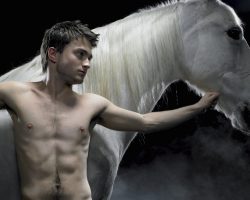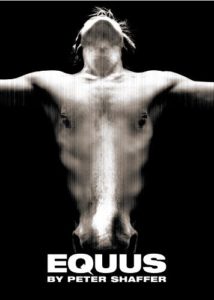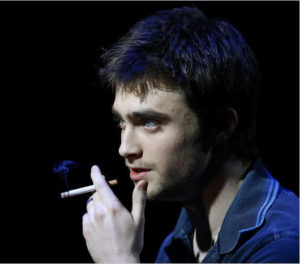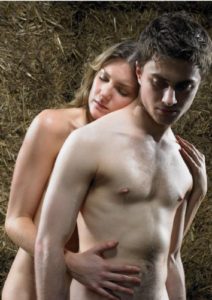
Equus with Daniel Radcliffe
Equus – starring Daniel Radcliffe and Richard Griffiths.
Equus the Play has been a hot topic of discussion amongst the theatre community for a long time.
In the Fall 2008, Broadway was graced by Harry Potter stars, Daniel Radcliffe and Richard Griffiths. They starred in the West End, sell out transfer, of Peter Shaffer’s Equus at The Broadhurst Theatre, NYC.
In this article you will find opinion of Equus the play, Equus reviews, and interviews with the stars of Equus, as well as how to get your hands on a copy of Equus the film, as well as the Equus play script and the Equus study guide.
Equus Theatre Poster, featuring Daniel Radcliffe
Isn’t it beautiful?

So, What Did I Think of Daniel Radcliffe in Equus?
honest, I thought it was alright, but I wanted more from Radcliffe. I saw the second preview, so his performance was still finding it’s feet (there was a rather embarrasment moment at the end, where Richard Griffiths had to show him how to bow!)
I really wanted to love this show, as I was in a production of it with a theatre company a few years previously, but I was left with a strange taste in my mouth. I couldn’t help feeling that there are better actors out there who could take on the role. Radcliffe was, for me, just OK. He didn’t have enough diversity in his performance, the only diversity was in his vocal projection – quiet, loud, or shouting. Richard Griffiths was superb, as I had hoped. The production as a whole was ‘revived’ from it’s original conception in the 70s, recreating the wired horse masks, as using a minimalistic set.
This show has created huge controversy, primarily due to one scene in Equus that sees Daniel Radcliffe nude, completely starkers, naked, no clothes, nada (and we’re not talking just shirtless either)…yes, gasp you might!
Daniel Radcliffe gets nude on stage
…or Harry Potter Gets His Wand Out
seeing Radcliffe’s disappointingly bland and shouty performance, I couldn’t help feeling that it was stunt casting that gave him the part. Having a name like, Daniel Radcliffe, in a lead role that goes fully naked on stage, is a guaranteed sell out. Who isn’t interested to see whether or not he actually takes his clothes off?
I find something awkward about it. I don’t know why. I’m not a prude by any means. I only find it distasteful because Radcliffe is so strongly associated with Harry Potter – an icon of children’s literature. Millions of children look up to him and adore him…and in the late 2000′s he was still a teenager and is appeared naked infront of hundreds of people. It’s just, I don’t know, kinda weird.
I suppose I also wouldn’t mind so much, if it wasn’t the topic of conversation every time someone talks about the show. If there’s a publicity shot for the show, it’s of Radcliffe topless. No one stops and talks to him about the fundamental issues of playing a young teenage character growing up and needing psychiatric care. No one talks about the interesting stage design or the beautiful horse masks. All people seem to care about is Daniel Radcliffe getting taking his clothes off and showing everyone his wand, so to speak.
Is Daniel Radcliffe Right For The Part?
Is it stunt casting? Are there better actors out there? Is Radcliffe too associated with Children’s Literature to go naked on stage?
Is Daniel Radcliffe right for the part of Alan Strang?
Alan Strang (Radcliffe)

Equus Synopsis and Study notes
*may contain spoilers*
Equus tells the story of a troubled stable lad, Alan Strang, who has an unusual relationship with his horses. Worshipping his god, Equus, it all seems relatively harmless. Then interactions with the stable girl, Jill, takes a course of action that leads him to be submitted to a psychiatric care. Persuaded by his life long confident, Dr. Martin Dysart, child psychologist, takes on the boy and begins to unravel what happened, and what led him to brutally attack and blind six horses with a metal spike – all the time dealing with his own demons.
Originally opening as a play in the 1970s, starring Anthony Hopkins as Dysart, Equus has gone on to marvel audiences and inspire discussion. Amazon currently stock a study guide to Peter Shaffer’s
Equus as a digital download.many
universities and drama departments study the text and play, as it raises interesting debate about the nature of theatre and rituals, as well as innocence and loss. An intriguing set of characters guide us through this troublesome story. Questions are raised about identity, religion and sex. How did a teenage boy become so ensnared in a faith, to the extent that his staunch beliefs would give him such powerful feelings of guilt and shame, that would lead him to attempt destroying his very own god. Emotionally charged, gripping and captivating. An extraordinary play that will stay with you, even after you’ve left the theatre.
Want to Know More About Daniel Radcliffe?
What other theatre has Daniel Radcliffe been doing since Equus?
Since Equus, Daniel Radcliffe has been busy! Not only did he have to finish off the Harry Potter films, but he has gained a few more theatrical accolades under his belt.
He went to Broadway and starred in the musical How To Succeed In Business Without Really Trying. The musical was a super hit and went down very well with critics.
In the middle of 2013, he then went to star in The Cripple on Inishmaan as part of the Michael Grandage season at the Noel Coward theatre, London. Another challenging role, not only by virtue of having to perfect an Irish accent, but also because he had to play his role with half his body contorted into a cripple-like stance. I saw it in June, and it was excellent!
What are the Twitterati saying about Equus?
Alan and Gill, the Stable Girl
This is the prelude to Daniel Radcliffe’s controversial sex scene that-never-actually-happens in Equus


